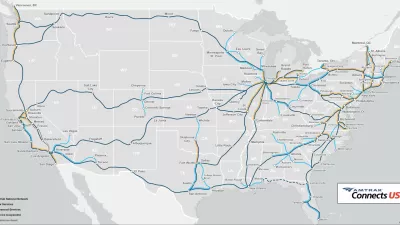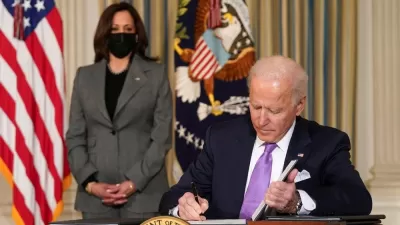Rice University Kinder Institute for Urban Research recently published "A Bottom-Up Infrastructure Strategy for American Renewal."

The Rice University Kinder Institute for Urban Research worked with former Secretary of the U.S. Department of Housing and Urban Development Henry Cisneros to publish a new report charting a path for "bottom-up" infrastructure investment for post-pandemic recovery.
The report surveys infrastructure priorities in 100 metropolitan areas and 134 cities across the country to 1,800 high-priority infrastructure projects (shown in an interactive map). Of that total, transportation, public facilities, water and wastewater, energy projects and communications projects appear most frequently on the list.
To meet the nation's infrastructure challenges (the result of decades of neglect preceding the pandemic), the report suggests a focus on three areas: post-pandemic infrastructure, climate resilience, and urban-rural connections.
An introductory article summarizes the "bottom-up" approach suggested in the report:
Too often U.S. infrastructure policy has taken a top-down approach, with the federal government dictating what will be built, based on inside-the-Beltway lobbying. But, in reality, the American economy is a network of regional and metropolitan economies. Cities and metropolitan areas are the true engines of American prosperity, and generate most of the economic output and most of the jobs. And they are economically connected to small towns and rural areas when they are part of the same mega-region. To meet the challenges listed above, the next American infrastructure strategy must include a market-based, bottom-up component that is responsive to the needs on the ground in cities, metros and regions.
The report suggests the local and regional leaders consult on the details of this infrastructure plan, so it's not suggesting a grassroots or community-led process sometimes connoted by the term "bottom-up."
FULL STORY: The US needs a bottom-up plan to fix its glaring infrastructure needs

Alabama: Trump Terminates Settlements for Black Communities Harmed By Raw Sewage
Trump deemed the landmark civil rights agreement “illegal DEI and environmental justice policy.”

Planetizen Federal Action Tracker
A weekly monitor of how Trump’s orders and actions are impacting planners and planning in America.

The 120 Year Old Tiny Home Villages That Sheltered San Francisco’s Earthquake Refugees
More than a century ago, San Francisco mobilized to house thousands of residents displaced by the 1906 earthquake. Could their strategy offer a model for the present?

Ken Jennings Launches Transit Web Series
The Jeopardy champ wants you to ride public transit.

BLM To Rescind Public Lands Rule
The change will downgrade conservation, once again putting federal land at risk for mining and other extractive uses.

Indy Neighborhood Group Builds Temporary Multi-Use Path
Community members, aided in part by funding from the city, repurposed a vehicle lane to create a protected bike and pedestrian path for the summer season.
Urban Design for Planners 1: Software Tools
This six-course series explores essential urban design concepts using open source software and equips planners with the tools they need to participate fully in the urban design process.
Planning for Universal Design
Learn the tools for implementing Universal Design in planning regulations.
Clanton & Associates, Inc.
Jessamine County Fiscal Court
Institute for Housing and Urban Development Studies (IHS)
City of Grandview
Harvard GSD Executive Education
Toledo-Lucas County Plan Commissions
Salt Lake City
NYU Wagner Graduate School of Public Service





























